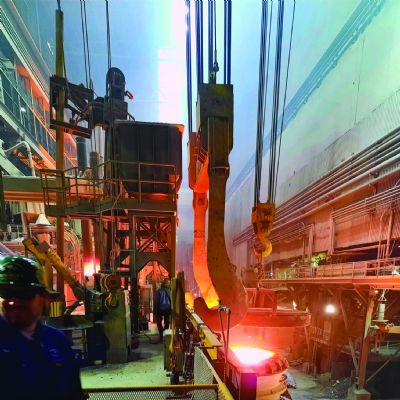.jpg) Integrated press-line automation: Automation seamlessly connects different stages of the hot stamping process, reducing cycle times, minimizing the number of errors and optimizing workflow.
Integrated press-line automation: Automation seamlessly connects different stages of the hot stamping process, reducing cycle times, minimizing the number of errors and optimizing workflow.
AI-enabled quality-control systems: These systems continuously monitor and adjust the hot stamping process in real time, identifying even the smallest defects before they become bigger problems. This ensures that every part meets the highest standards and reduces waste and rework in a big way. Even more impressive? According to one source, AI-driven quality-control systems can achieve a 95% accuracy rate in defect detection.
Automated die-handling equipment: Automated die-handling equipment is transforming hot stamping by enabling swift and precise die changes, thus reducing downtime between production runs. For manufacturers, it means smoother operations, lower labor costs and the ability to switch between product specs in no time.
So, what’s in it for you? Faster production, fewer defects and lower labor costs, all while boosting safety.
Additional Technological Advances for Hot Stamping
Technology has changed how we work in incredible ways, and as the calendar pages turn, more advancements in metal forming technology promise to revolutionize industries across the board.
Predictive maintenance: These systems are changing the way that manufacturers approach equipment upkeep. Real- time data can predict when a machine might fail and schedule maintenance before it disrupts production.
Vision systems: Inline vision systems utilize heat-resistant cameras and sensors to monitor the precise positioning of heated blanks and detect any surface defects or misalignments during the stamping process. This technology allows manufacturers to ensure perfect part quality in real time, even under extreme conditions of high temperatures and rapid production cycles.
Laser cutting and marking: Hot stamping renders very rigid parts. Laser cutting and marking offer precise and efficient ways to trim parts and apply permanent identification or traceability marks directly onto hot-stamped components. This technology allows manufacturers to make intricate cuts with high accuracy, even on complex geometries, and ensures clear, durable markings for tracking and quality assurance. By integrating laser systems, manufacturers can streamline post-stamping processes, reduce manual intervention and enhance production speed without sacrificing precision.
Best Practices for Implementing Automation
If you’ve decided to upgrade the automation in your hot stamping operations, now comes the fun part: ensuring that you don’t just add some shiny new robots to the mix and call it a day.
Begin by evaluating your current processes. Ask yourself the tough questions: What are the pain points in your current process that keep you awake staring bleakly at the ceiling at 3 a.m.? Where are the bottlenecks?
Next, work with automation experts to select the right technology. They’ll help identify the right equipment to attack those pesky pain points. Automation experts also will help you evaluate compatibility with existing systems. You don’t want to make the mistake of adopting tech that won’t integrate seamlessly with your current equipment and production lines. They’ll also guide you on scalability and ROI.
What’s the takeaway? Transparency. Do all you can to engage your workforce in the transition to automation by communicating the benefits and addressing concerns. If your staff feels included in the process, they’re less likely to balk at adopting the new technology. At the same time, focus on safety and compliance. Protocols must be in place for working with automated machinery to protect workers from accidents.
When it comes to implementation, do it slowly, like easing into a chilly pool—one toe at a time, to avoid any unpleasant shocks. Start with a pilot program using a controlled section of your production line. You’ll need to set a realistic timeline for implementation; one that allows for testing, training and unavoidable adjustments.
Future Trends
The only constant is change. It’s no different with hot stamping automation. Emerging technologies will continue to shape the way that manufacturing takes place.
AI process optimization will continue advancing. Algorithms will analyze and adjust the hot stamping process continuously in real time, leading to optimized performance, a reduction in defects and overall efficiency.
The development of new, ultralightweight, high-strength materials pushes the boundaries of current tech and requires specialized hot stamping processes and new automation systems.
What else? Next-generation servo technology will offer even greater precision, speed and flexibility in hot stamping applications.
The future isn’t just about keeping up. It’s about staying ahead. Advanced automation will help you scale up, hit deadlines and improve your bottom line without sacrificing quality. MF
View Glossary of Metalforming Terms
See also: Macrodyne Technologies, Inc.
Technologies: Pressroom Automation, Stamping Presses







 Even small manufacturers have taken note. With the help of automation, they can compete head-to-head with larger competitors and gain a fighting chance in a market that once seemed out of reach.
Even small manufacturers have taken note. With the help of automation, they can compete head-to-head with larger competitors and gain a fighting chance in a market that once seemed out of reach.
 Podcast
Podcast
